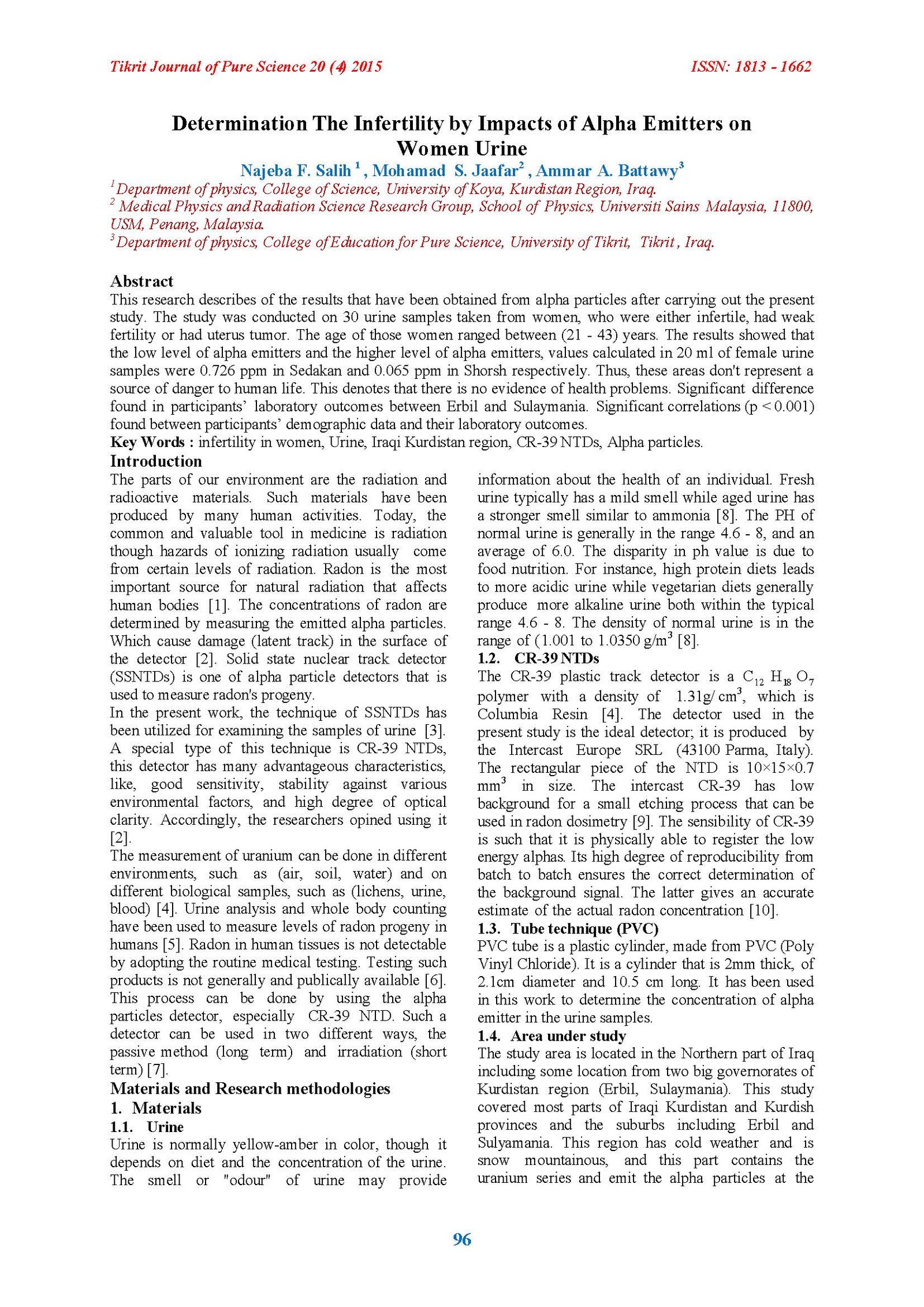Determination The Infertility by Impacts of Alpha Emitters on Women Urine
Main Article Content
Abstract
This research describes of the results that have been obtained from alpha particles after carrying out the present study. The study was conducted on 30 urine samples taken from women, who were either infertile, had weak fertility or had uterus tumor. The age of those women ranged between (21 - 43) years. The results showed that the low level of alpha emitters and the higher level of alpha emitters, values calculated in 20 ml of female urine samples were 0.726 ppm in Sedakan and 0.065 ppm in Shorsh respectively. Thus, these areas don't represent a source of danger to human life. This denotes that there is no evidence of health problems. Significant difference found in participants’ laboratory outcomes between Erbil and Sulaymania. Significant correlations (p < 0.001) found between participants’ demographic data and their laboratory outcomes.
Article Details

This work is licensed under a Creative Commons Attribution 4.0 International License.
Tikrit Journal of Pure Science is licensed under the Creative Commons Attribution 4.0 International License, which allows users to copy, create extracts, abstracts, and new works from the article, alter and revise the article, and make commercial use of the article (including reuse and/or resale of the article by commercial entities), provided the user gives appropriate credit (with a link to the formal publication through the relevant DOI), provides a link to the license, indicates if changes were made, and the licensor is not represented as endorsing the use made of the work. The authors hold the copyright for their published work on the Tikrit J. Pure Sci. website, while Tikrit J. Pure Sci. is responsible for appreciate citation of their work, which is released under CC-BY-4.0, enabling the unrestricted use, distribution, and reproduction of an article in any medium, provided that the original work is properly cited.
References
[1] Dua N. et al. (2011). Determination of radon using solid state nuclear tracks wireless sensing method.
Analytica Chimica Acta 686 121–125.Contents lists available at Scienc. Direct. Analytica Chimica Acta journal. Elsevier.
[2] Pires M. et al (2007). Calibration of the Solid State Nuclear Track Detector CR-39 for Radon measurement.978-85-99141-02-1Instituto de Pesquisas Energéticas de Nucleares. Professor Lineu Prestes 2242N 05508-000 São Paulo, SP.
[3] Akoto N. et al. (2011).Indoor radon levels and the associated effective dose rate determination at Dome in the Greater Accra region of Ghana. Research Journal of Environmental and Earth Sciences 3(2): 124-130.
[4] Zhu G. et al. (2009). Accumulation and distribution of uranium in rats after implantation with depleted uranium fragment. Res., 50, 183–192. J. Radiat. Res., Vol. 50, No. 3.
[5] Hussein A. S. (2008). Radon in the environment friend or foe. Proceedings of the 3rd Environmental Physics Conference, 19-23 Nuclear Power Plants Authority, Cairo, Egypt.
[6] Tyburski J. B. et al. (2008). Radiation metabolomics identification of minimally invasive urine biomarkers for gamma-radiation exposure in mice. Radiat. Res.170,1–14.
[7] Crawford J. et al (2008). Toxicological profile for phenol U.S. department of health and human services. Public health service agency for toxic substances and disease registry.
[8] Shaimaʹa T. A. (2009). Determination of alpha emitters concentration in human urine via PM-355 SSNT Detector. A Thesis the Msc. of Science in Physics. Al-Nahrain.
[9] Sek J.K. et al. (2006). Measurement of alpha emitters concentration in the some soft drinks. Bangladesh Jornal, 2(1).
[10] Obed R. I. et al. (2011). Radon measurements by nuclear track detectors in Dwelling in Oke-Ogun area South Western, Nigeria. Radiation Protection Dosimetry, pp. 1–7.
[11] Kurdistan: Wikipedia, (2011): The free encyclopedia Page at 14:29.
[12] Tsivou M. et al. (2009). Stabilization of human urine doping control samples. 388,146–154 Contents lists available at Science Direct Analytical Biochemistry journal.
[13] Agata A. M. (2009). Determination of cyclophosph amide in human urine by coupled to tandem mass spectrometry Eng. Department of analytical chemistry. Master thesis Gdansk university of technology chemical faculty.
[14] Milenkovi B. (2010). A simulation of neutron interaction from Ame Be source with the CR-39 detector. Radiation Measurements, 1338e1341 34000 Kragujevac, Serbia Contents lists available at Science Direct Radiation Measurements - Elsevier, 45.
[15] Saad A. F. et al. (2010). Radon exhalation rate from building materials used on the Garyounis University campus, Benghazi, Libya” Turkish J. Eng. Env. Sci. 34, 67 – 74.
[16] Rafique M. (2010). Assessment of indoor radon dose received by the students in The Azad Kashmir schools Pakistan. Radiation Protection Dosimetry Vol. 142, No. 2–4.
